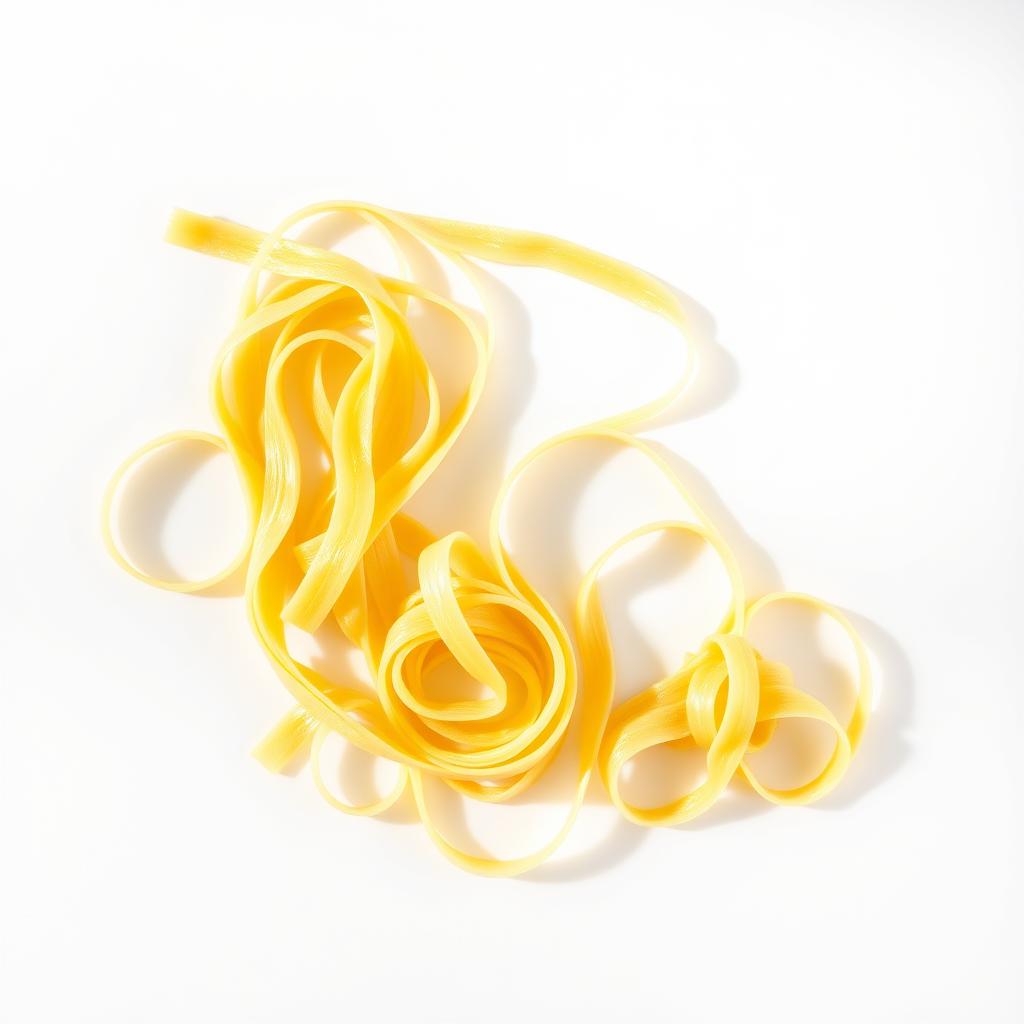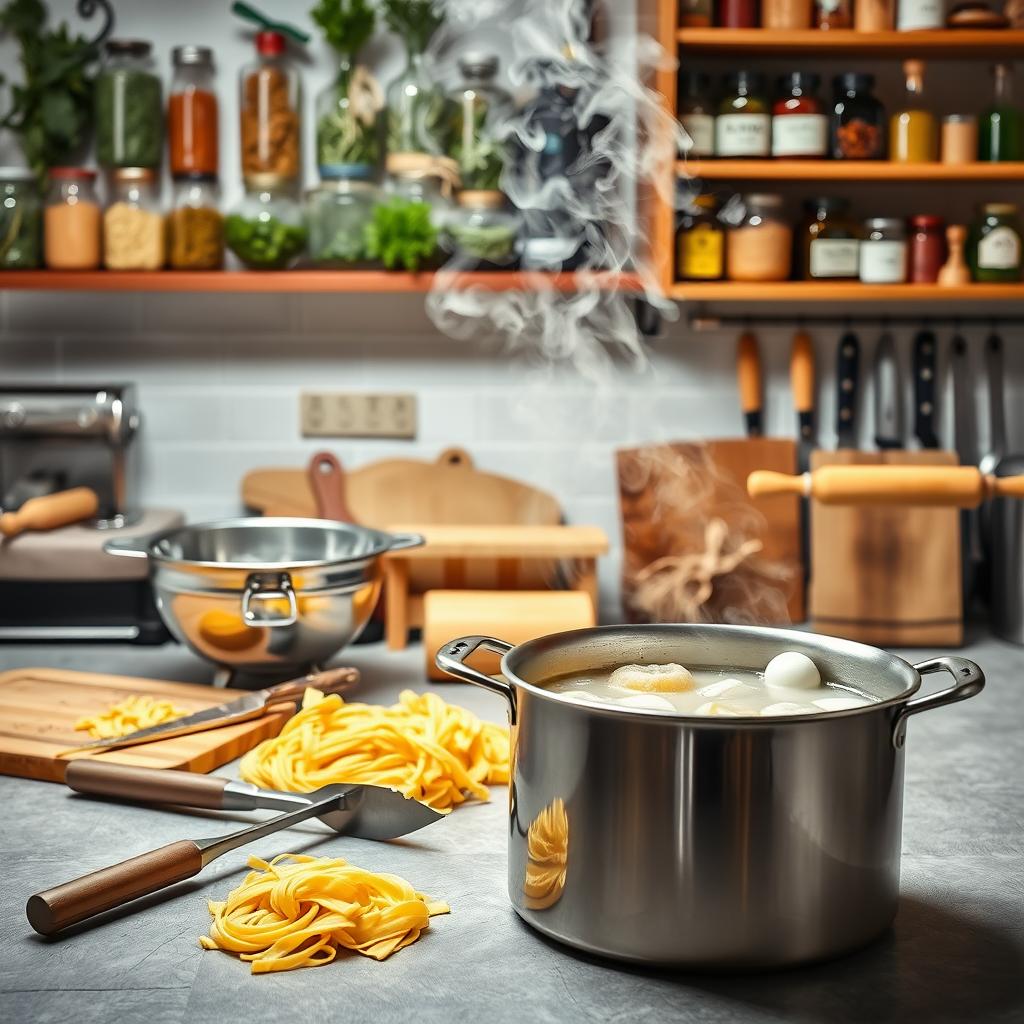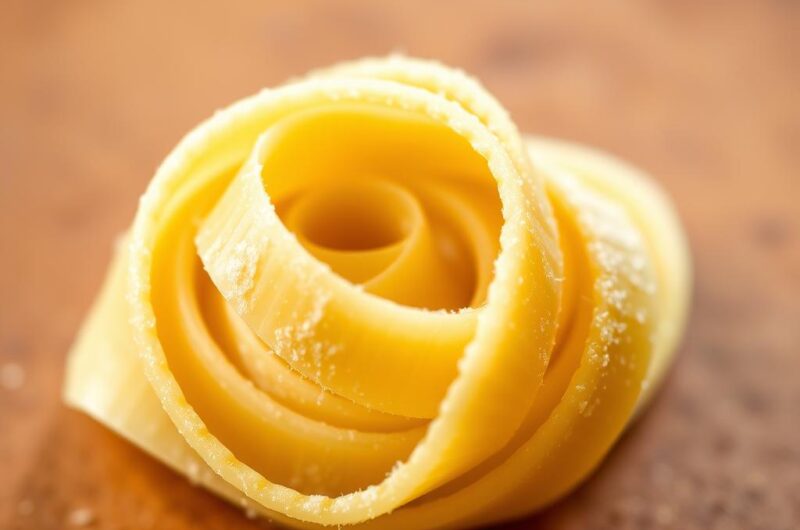The Best Fluffy Pancakes recipe you will fall in love with. Full of tips and tricks to help you make the best pancakes.
Mafaldine is a ribbon-shaped pasta loved in Italy, known for its fancy dishes. It comes from Naples and was named after Princess Mafalda. This shows its royal background.
This gourmet pasta has a special shape, flat and wide. It’s perfect for many sauces. Its soft texture and taste go well with both light and thick sauces, making meals better.
Mafaldine is a hit with chefs and pasta lovers. Its elegance and versatility show Italy’s deep love for food.
Key Takeaways
- Mafaldine is a type of ribbon-shaped pasta originating from Naples.
- It is known for its flat and wide shape, ideal for various sauces.
- Mafaldine pairs well with both light and rich sauces.
- It is a favorite among chefs for its versatility and elegance.
- Mafaldine is a staple in sophisticated Italian dishes.
Understanding Mafaldine Pasta
To truly appreciate mafaldine pasta, one must understand its origins and what makes it special. It has a rich history named after Princess Mafalda, daughter of King Victor Emmanuel III of Italy.
Origin and Historical Significance
Mafaldine pasta was created in honor of Princess Mafalda of Savoy. It shows the Italian tradition of making pasta with historical and royal connections. This pasta type is a symbol of Italian culinary heritage, blending tradition with nobility.
Distinctive Characteristics and Shape
Mafaldine is known for its long, ribbon-like strips with crimped edges. It’s a visually appealing and unique pasta shape. The ribbon shape is not only beautiful but also holds onto sauces well, making meals more enjoyable.
| Characteristics | Description | Benefits |
|---|---|---|
| Ribbon-like shape | Long strips with crimped edges | Visually appealing, holds sauces well |
| Historical significance | Named after Princess Mafalda | Adds a touch of nobility to meals |
| Culinary versatility | Pairs well with various sauces | Enhances dining experience with flexibility |

The Unique Appeal of Ribbon-Shaped Pasta
Mafaldine pasta’s ribbon shape is a game-changer in gourmet pasta dishes. This unique shape not only adds visual appeal but also enhances the overall dining experience.
Visual Aesthetics on the Plate
The ribbon shape of mafaldine pasta brings an element of elegance to the plate. Its wavy edges and flat surface make it a visually appealing choice for gourmet pasta presentations. Chefs often choose mafaldine for its ability to elevate the visual appeal of a dish.

Texture and Mouthfeel Benefits
The texture and mouthfeel of mafaldine pasta are significantly enhanced by its ribbon shape. The flat surface provides a satisfying bite, while the wavy edges add a delicate texture. This combination creates a pleasing mouthfeel that complements a variety of sauces.
Superior Sauce-Holding Capabilities
One of the key advantages of mafaldine’s ribbon shape is its ability to hold sauces effectively. The wavy edges and flat surface work together to trap and carry sauces, ensuring that each bite is flavorful. This makes mafaldine an excellent choice for a wide range of pasta dishes.
| Benefits of Ribbon-Shaped Pasta | Description |
|---|---|
| Visual Appeal | Enhances the presentation of dishes with its elegant shape |
| Texture and Mouthfeel | Provides a satisfying bite and delicate texture |
| Sauce-Holding Capabilities | Traps and carries sauces effectively for flavorful bites |
Essential Equipment for Cooking Mafaldine
Mafaldine pasta has a special ribbon shape. It needs specific kitchen tools for the best cooking. Having the right equipment is key.
Necessary Pots and Utensils
To cook mafaldine, start with a large, deep pot. A pot of at least 4 quarts is best. It lets the pasta cook well.
A colander is crucial for draining the pasta. A long-handled slotted spoon or pasta fork helps in getting the pasta out of the water. “The right pot can make all the difference in cooking pasta,” say experts.
Optional Specialized Tools for Better Results
A pasta machine is not essential but helpful for homemade mafaldine. It controls the pasta’s thickness, improving texture and cooking. Using a timer ensures perfect al dente doneness.
For a better pasta cooking experience, consider these specialized tools. They can make a big difference.

How to Select Quality Mafaldine Pasta
Choosing the right mafaldine pasta is key for a great meal. You have to decide between fresh and dried pasta.
Fresh vs. Dried Options: Pros and Cons
Fresh mafaldine pasta is soft and tastes richer because it’s made with eggs. But, it doesn’t last long and needs careful storage. Dried mafaldine pasta lasts longer and is easier to store. It’s a better choice for many.
Choose based on your recipe and what you like.
Ingredient Quality Indicators to Look For
Good Italian pasta uses quality semolina flour. Look for ‘semolina flour’ or ‘durum wheat semolina’ as the main ingredient. Stay away from products with extra additives or preservatives.
The pasta should be a bright, even yellow. This shows it’s made from high-quality durum wheat.

Where to Purchase Authentic Mafaldine
You can find real mafaldine pasta at Italian grocery stores or specialty food stores. When buying mafaldine pasta online, make sure it’s from a trusted source. Look for products from Italy or well-known Italian pasta makers.
Check customer reviews and product descriptions to confirm it’s genuine.
| Purchase Location | Pros | Cons |
|---|---|---|
| Italian Grocery Stores | Authentic products, expert advice | Limited geographical availability |
| Online Retailers | Convenient, wide selection | Risk of counterfeit products |
| Specialty Food Stores | High-quality products, knowledgeable staff | Potentially higher prices |
Step-by-Step Guide to Cooking Perfect Mafaldine Pasta
Cooking Mafaldine pasta is simple. Just follow a few steps and pay attention to detail. This way, you’ll get a dish that highlights the pasta’s unique shape.
Water-to-Pasta Ratio for Optimal Results
Getting the water-to-pasta ratio right is key. Use 4-6 quarts of water for every pound of pasta. This amount prevents the pasta from sticking and ensures it cooks evenly.
Salt and Seasoning Techniques
Don’t skip salting the water. Add about 1-2 tablespoons of salt for every pound of pasta. It seasons the pasta and improves its texture. You can also add bay leaves or garlic for extra flavor.
Cooking Time Guidelines by Brand
Cooking time varies by brand and type. Generally, it takes 8-12 minutes to cook Mafaldine pasta until al dente. Always check the package for specific cooking times.
Testing for Perfect Al Dente Doneness
The al dente stage is crucial for perfect pasta. It should have a bit of chew. To check, bite into a piece of pasta. If it’s too hard, keep cooking and testing until it’s right.
Proper Draining Techniques
After cooking, drain the pasta in a colander. Avoid rinsing the pasta as it can lose the starches that help sauces stick. Gently shake the colander to remove excess water. Then, return the pasta to the pot or a serving dish to toss with your sauce.
Making Homemade Mafaldine Pasta from Scratch
For those who love Italian cuisine, making homemade mafaldine pasta is a fun journey. It involves making a simple dough, kneading it, and then rolling and cutting it into the mafaldine shape.
Essential Ingredients for Perfect Dough
The key to great homemade mafaldine pasta is a well-made dough. You’ll need ’00’ flour or semolina flour, eggs, and a pinch of salt. High-quality semolina flour is important for flavor and texture. Fresh, large eggs add richness and color to the dough.
Kneading and Resting Process
Kneading the dough is crucial for developing the gluten. This gives the pasta its bite. Knead for about 10 minutes until it’s smooth and elastic. Then, let it rest for at least 30 minutes to relax the gluten.
Rolling and Cutting Techniques
To get the mafaldine shape, roll out the dough thinly. You can use a pasta machine or a rolling pin. Cut the dough into long, flat ribbons, about 1 cm wide. A pasta machine helps ensure even thickness for even cooking.
Here’s a quick overview of the ingredients and steps involved in making homemade mafaldine pasta:
| Ingredient/Step | Description | Importance |
|---|---|---|
| Semolina Flour | High-protein flour ideal for pasta | High |
| Eggs | Fresh, large eggs for richness and color | High |
| Kneading | Develops gluten for the right texture | High |
| Resting | Relaxes gluten for easier rolling | Medium |
| Rolling & Cutting | Creates the signature mafaldine shape | High |
Common Mistakes to Avoid When Preparing Mafaldine
To enjoy mafaldine pasta, avoid common mistakes. These can ruin its delicate texture and flavor. Cooking mafaldine needs finesse because of its unique shape and texture.
Overcooking Issues and Solutions
One big mistake is overcooking mafaldine. Overcooking makes it mushy, which is not good. To fix this, cook it in boiling, salted water and check it often. It should be al dente, still having a bit of chew.
Rinsing Misconceptions Explained
Many think rinsing pasta stops cooking and removes starch. But, rinsing can cool the pasta and make sauces stick less. For mafaldine, drain it and toss it with sauce right away. This helps the sauce stick well.
Sauce Pairing Errors to Prevent
Mafaldine’s shape is great for creamy or light sauces. Don’t use thick or chunky sauces that can make it heavy. Choose sauces that match its delicate texture, like tomato sauce or creamy Alfredo.
Best Sauce Pairings for Mafaldine Pasta
Mafaldine pasta has a unique ribbon shape. It’s great for many sauces. Its texture and shape work well with both classic and new sauces.
Traditional Italian Sauces That Complement the Shape
Traditional Italian sauces go well with mafaldine pasta. The pasta’s flat edges hold onto sauces, making each bite tasty.
Ragù and Meat-Based Options
Ragù alla Napoletana is a great choice. It’s a meat ragù from Naples. The rich flavor of the ragù matches the pasta’s texture. Italian chef Giorgio Locatelli said,
“Pasta is the foundation, and the sauce is the building that you construct on top of it.”
Cream-Based Classics
Cream-based sauces like Carbonara or Alfredo are also good. They coat the pasta with a creamy texture. Try a simple sauce with heavy cream, Parmesan, and nutmeg.
Modern Fusion Sauce Ideas
Modern sauces can make mafaldine pasta exciting. Try a spicy Korean gochujang sauce or a pesto with basil and lemon. These creative pasta pairings add a twist to Italian dishes.
Vegetarian and Vegan Sauce Alternatives
There are many vegetarian and vegan options. A mushroom ragù or a roasted vegetable sauce works well. For a vegan sauce, mix roasted garlic, olive oil, and herbs.
Mafaldine pasta is loved for its sauce versatility. It suits both classic and modern sauces. Find the perfect sauce for your mafaldine, whether it’s traditional or innovative.
Signature Mafaldine Pasta Recipes to Try
Exploring mafaldine pasta recipes is a culinary adventure. Its unique shape and texture are perfect for many flavors. Here are some signature recipes to try.
Classic Mafaldine with Bolognese Sauce
Classic Mafaldine with Bolognese Sauce is a beloved Italian dish. It combines ground beef, pork, and tomatoes with mafaldine pasta. Cook the pasta al dente, then mix it with a slow-cooked bolognese sauce.
The sauce is made with ground meats, onions, carrots, celery, tomatoes, and red wine. Finish with freshly grated Parmesan cheese.
Creamy Wild Mushroom Mafaldine
Creamy Wild Mushroom Mafaldine is a creamy and earthy dish. Sauté wild mushrooms in butter until tender. Then, add heavy cream and cook until slightly reduced.
Toss the sauce with cooked mafaldine pasta. Top with grated Parmesan and fresh parsley for a decadent meal.
Mediterranean Seafood Mafaldine
Mediterranean Seafood Mafaldine brings the sea to your table. Cook mafaldine pasta and mix it with a seafood medley. The medley includes shrimp, scallops, and mussels.
Cook the seafood in a light sauce. The sauce is made with garlic, lemon juice, white wine, and herbs like parsley and basil.
Baked Mafaldine Pasta Casserole
Baked Mafaldine Pasta Casserole is a comforting meal. Mix cooked mafaldine with a rich tomato sauce, ricotta cheese, and shredded mozzarella.
Transfer the mixture to a baking dish. Top with more mozzarella and Parmesan. Bake until golden and bubbly.
Serving and Presentation Tips for Impressive Meals
Improving your pasta dishes starts with presentation. The look of your gourmet pasta can make your meal better. It makes the dining experience more fun and memorable.
Restaurant-Quality Plating Techniques
To look like a restaurant, use a big, white plate. This contrasts well with your pasta dishes. Put a bit of mafaldine in the middle, a bit off-center for interest.
Twirl the pasta with a fork to make a neat mound. This makes your dish look inviting.
Creative Garnishing Ideas
Adding fresh herbs like basil or parsley can make your pasta presentation stand out. A sprinkle of Parmesan cheese or a drizzle of olive oil adds flavor and looks good. Cherry tomatoes or edible flowers can add color.
Conclusion
Mafaldine pasta is a versatile and elegant Italian pasta shape. It’s great for many dishes, from traditional to modern. Its unique ribbon shape and smooth texture make it perfect for many sauces.
Understanding mafaldine pasta’s characteristics and following cooking tips can help you make delicious meals. Whether you make it at home or buy it, cooking it right is key. Pairing it with the right sauces is also important.
Mafaldine pasta has a rich history and looks great on a plate. It holds sauces well, making it a kitchen staple. Try different recipes and sauces to see all it can do.
FAQ
What is mafaldine pasta?
How do I cook mafaldine pasta?
What sauces pair well with mafaldine pasta?
Can I make homemade mafaldine pasta?
What are the benefits of using fresh mafaldine pasta over dried?
How do I store leftover mafaldine pasta?
Can I use mafaldine pasta in baked dishes?
What are some common mistakes to avoid when cooking mafaldine pasta?
Where can I buy authentic mafaldine pasta?
How do I achieve the perfect al dente texture when cooking mafaldine pasta?
Mafaldine Pasta: A Flavorful Pasta Adventure
Course: Main courseCuisine: ItalianDifficulty: Easy4
servings30
minutes40
minutes300
kcalMafaldine pasta, also known as Reginette or Mafalda, is a beautifully ribboned pasta named after Princess Mafalda of Savoy. Its ruffled edges are perfect for holding onto rich sauces, making it a luxurious choice for both simple and hearty dishes. This recipe pairs Mafaldine with a velvety tomato cream sauce and sautéed mushrooms for an elegant yet comforting meal.
Ingredients
- For the pasta and sauce:
250g (9 oz) Mafaldine pasta
2 tbsp olive oil
1 small onion, finely chopped
2 garlic cloves, minced
200g (7 oz) cremini or button mushrooms, sliced
400g (14 oz) canned crushed tomatoes
100ml (1/2 cup) heavy cream
Salt and black pepper to taste
Pinch of red pepper flakes (optional)
Fresh basil leaves, for garnish
Grated Parmesan cheese, for serving
Directions
- Cook the pasta:
Bring a large pot of salted water to a boil. Cook the Mafaldine pasta according to package instructions until al dente. Reserve 1/2 cup of pasta water, then drain and set aside. - Sauté the aromatics:
In a large skillet, heat olive oil over medium heat. Add chopped onion and cook until translucent, about 3–4 minutes. Stir in minced garlic and cook for 30 seconds until fragrant. - Cook the mushrooms:
Add the sliced mushrooms to the pan and sauté until golden and tender, about 6–8 minutes. Season lightly with salt and pepper. - Make the sauce:
Pour in the crushed tomatoes and stir. Simmer on low heat for 10 minutes to let the flavors meld. Add red pepper flakes if using. - Add cream:
Stir in the heavy cream and simmer for another 2–3 minutes. Adjust salt and pepper to taste. - Combine:
Add the cooked Mafaldine pasta to the sauce. Toss to coat, adding a bit of reserved pasta water if needed to loosen the sauce. - Serve:
Plate the pasta and top with grated Parmesan and fresh basil. Serve warm.
Notes
- You can substitute heavy cream with half-and-half for a lighter version.
- Add cooked sausage or pancetta for extra protein.
- Mafaldine works great with ragù, creamy sauces, or seafood—feel free to experiment!
- Store leftovers in an airtight container in the fridge for up to 2 days.






